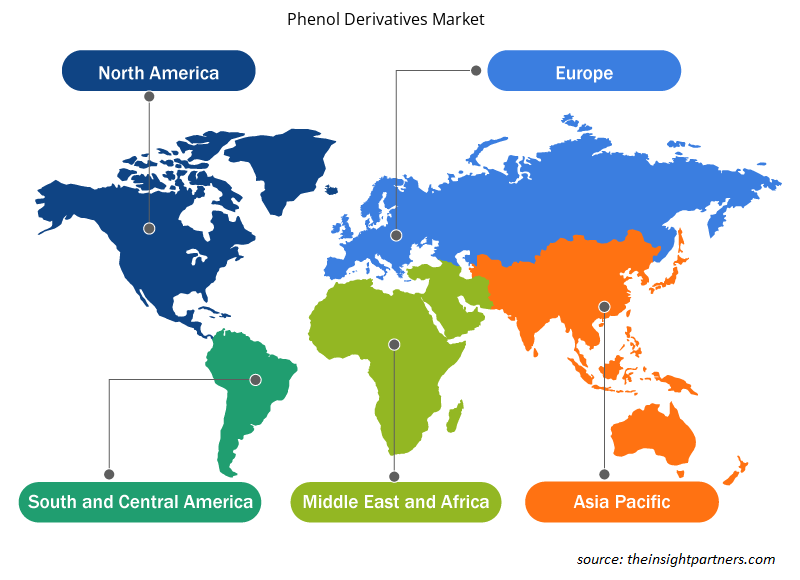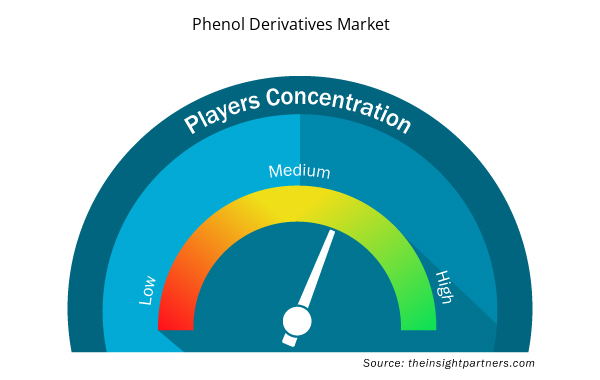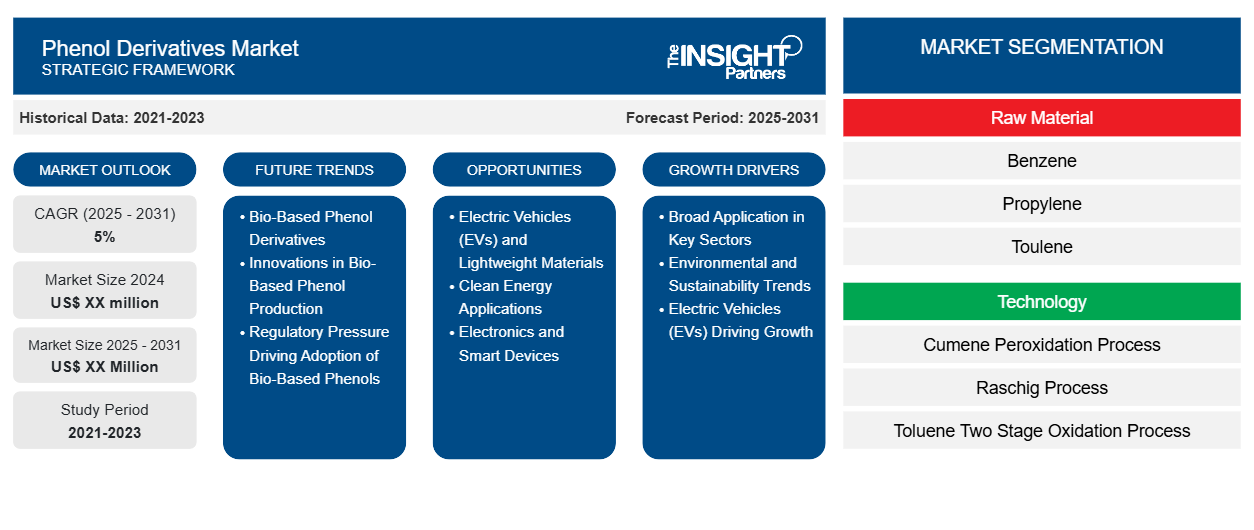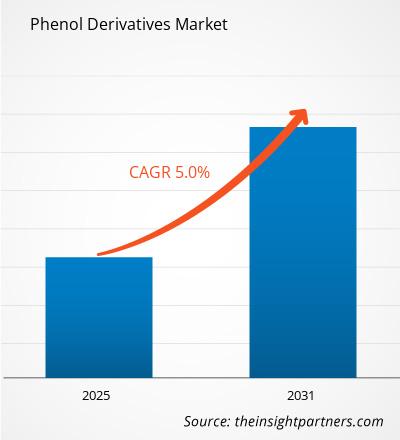Es wird erwartet, dass der Markt für Phenol-Derivate von 2023 bis 2031 eine durchschnittliche jährliche Wachstumsrate (CAGR) von 5 % verzeichnet, wobei die Marktgröße von XX Millionen US-Dollar im Jahr 2023 auf XX Millionen US-Dollar im Jahr 2031 wächst.CAGR of 5% from 2023 to 2031, with a market size expanding from US$ XX million in 2023 to US$ XX Million by 2031.
Der Bericht präsentiert eine Analyse basierend auf Rohstoffen (Benzol, Propylen und Toluol). Der Bericht ist nach Technologie segmentiert (Cumolperoxidationsverfahren, Raschig-Verfahren, Toluol-Zweistufenoxidationsverfahren und Sulfonierungsverfahren). Der Bericht ist nach Derivaten segmentiert (Bisphenol A, Phenolharze, Caprolactam, Alkylphenol und andere). Die globale Analyse ist weiter auf regionaler Ebene und in die wichtigsten Länder unterteilt. Die Marktgröße und -prognose auf globaler, regionaler und Länderebene für alle wichtigen Marktsegmente werden im Rahmen des Berichts abgedeckt. Der Bericht bietet den Wert in USD für die oben genannte Analyse und die Segmente. Der Bericht bietet wichtige Statistiken zum Marktstatus der wichtigsten Marktteilnehmer und bietet Markttrends und -chancen.propylene, and toulene). The report is segmented by technology (cumene peroxidation process, raschig process, toluene two stage oxidation process, and sulphonation process). The report is segmented by derivative (bisphenol-A, phenolic resins, caprolactam, alkyl phenol, and others). The global analysis is further broken-down at regional level and major countries. The market size and forecast at global, regional, and country levels for all the key market segments are covered under the scope. The report offers the value in USD for the above analysis and segments. The report provides key statistics on the market status of the key market players and offers market trends and opportunities.
Zweck des Berichts
Der Bericht Phenol Derivatives Market von The Insight Partners zielt darauf ab, die aktuelle Situation und das zukünftige Wachstum sowie die wichtigsten treibenden Faktoren, Herausforderungen und Chancen zu beschreiben. Dies wird verschiedenen Geschäftspartnern Einblicke geben, wie zum Beispiel:
- Technologieanbieter/-hersteller: Um die sich entwickelnde Marktdynamik zu verstehen und die potenziellen Wachstumschancen zu kennen, damit sie fundierte strategische Entscheidungen treffen können.
- Investoren: Durchführung einer umfassenden Trendanalyse hinsichtlich der Marktwachstumsrate, der finanziellen Marktprognosen und der Chancen entlang der Wertschöpfungskette.
- Regulierungsbehörden: Zur Regulierung von Richtlinien und Überwachungsaktivitäten auf dem Markt mit dem Ziel, Missbrauch zu minimieren, das Vertrauen der Anleger zu bewahren und die Integrität und Stabilität des Marktes aufrechtzuerhalten.
Marktsegmentierung für Phenolderivate
Rohstoff
- Benzol
- Propylen
- Toulene
Technologie
- Cumolperoxidationsverfahren
- Raschig-Verfahren
- Zweistufiger Toluol-Oxidationsprozess
- Sulfonierungsprozess
Derivat
- Bisphenol A
- Phenolharze
- Caprolactam
- Alkylphenol
Geographie
- Nordamerika
- Europa
- Asien-Pazifik
- Süd- und Mittelamerika
- Naher Osten und Afrika
Geographie
- Nordamerika
- Europa
- Asien-Pazifik
- Süd- und Mittelamerika
- Naher Osten und Afrika
Passen Sie diesen Bericht Ihren Anforderungen an
Sie erhalten kostenlose Anpassungen an jedem Bericht, einschließlich Teilen dieses Berichts oder einer Analyse auf Länderebene, eines Excel-Datenpakets sowie tolle Angebote und Rabatte für Start-ups und Universitäten.
- Holen Sie sich die wichtigsten Markttrends aus diesem Bericht.Dieses KOSTENLOSE Beispiel umfasst eine Datenanalyse von Markttrends bis hin zu Schätzungen und Prognosen.
Wachstumstreiber auf dem Markt für Phenolderivate
- Breite Anwendung in Schlüsselsektoren: Der Markt für Phenolderivate wächst aufgrund der steigenden Nachfrage in verschiedenen Sektoren. Phenolverbindungen werden bei der Herstellung von Kunststoffen, Harzen und Klebstoffen eingesetzt – diese sind Schlüsselelemente in der Automobil-, Bau- und Konsumgüterindustrie. Dieses breite Anwendungsgebiet treibt anhaltende Innovationen und Kapazitätserweiterungen voran.
- Umwelt- und Nachhaltigkeitstrends: Neben solchen Faktoren verändern Markttrends aufgrund umweltfreundlicher Produkte auch die Art und Weise, wie Industrien den Markt mit nachhaltigen Alternativen angehen sollten. So haben Hersteller begonnen, sich mit biobasierten Phenolen und Derivaten zu befassen. Dies spiegelt einerseits globale Nachhaltigkeitsziele wider und weckt die Aufmerksamkeit umweltbewusster Verbraucher, wodurch das Marktpotenzial erhöht und die Investitionen in Forschung und Entwicklung umweltfreundlicherer Alternativen vorangetrieben werden.
- Elektrofahrzeuge (EVs) treiben das Wachstum an: Auch die Automobilindustrie trägt weiterhin stark zum Wachstum dieses Marktes bei. Um Leistung und Haltbarkeit zu verbessern, ist eine erhöhte Produktion von Leichtbaumaterialien und fortschrittlichen Verbundwerkstoffen erforderlich, da hier Phenolharze zum Einsatz kommen. Darüber hinaus wird mit der Zunahme von Elektrofahrzeugen die Nachfrage nach Hochleistungsmaterialien wie Phenolderivaten diesen Markt noch weiter ankurbeln.
Zukünftige Trends auf dem Markt für Phenolderivate
- Biobasierte Phenolderivate: Eine nachhaltige Lösung: Zu den bevorstehenden Entwicklungen, die sich direkt auf die phänomenologischen Merkmale des Marktes für Phenolderivate auswirken würden, gehört die biobasierte Entwicklung von Phenolderivaten. Da Unternehmen nach den umweltfreundlichsten Wegen suchen, um Ersatzquellen für die traditionellen petrochemischen Quellen zu finden, gewinnen erneuerbare Quellen für biobasierte Phenole ebenfalls stark an Bedeutung, nicht nur, weil sie den CO2-Fußabdruck erheblich reduzieren, sondern auch perfekt mit den Nachhaltigkeitszielen übereinstimmen, die sich die Nationen der Welt gesetzt haben.
- Innovationen in der biobasierten Phenolproduktion: Die Vorteile der Technologie- und Prozessentwicklung im Hinblick auf Innovationen im Zusammenhang mit der biobasierten Phenolproduktion ergeben sich aus der Forschung mit verschiedenen Biomassequellen. Zu diesen Quellen gehören Lignin und Pflanzenmaterialien. Solche neuen Entwicklungen ermöglichen eine effiziente Extraktion von Phenolverbindungen, was biobasierte Phenole im Vergleich zu herkömmlichen Phenolen für viele Anwendungen rentabler und wirtschaftlicher macht.
- Regulierungsdruck fördert die Einführung biobasierter Phenole: Der wachsende Regulierungsdruck zur Einführung umweltfreundlicherer Verfahren treibt die Nachfrage nach diesen biobasierten Phenolderivaten an. Dieser Trend dürfte ein großer Anreiz für Marktwachstum und Investitionsanreize sowie für die Zusammenarbeit zwischen Interessengruppen im Chemiesektor sein, da Unternehmen nachhaltige Produkte entwickeln, die den Verbraucherpräferenzen für umweltfreundliche Materialien entsprechen.
Marktchancen für Phenol-Derivate
- Elektrofahrzeuge (EVs) und Leichtbaumaterialien: Neue Branchen bringen neuartige Anwendungen hervor, die enorme Wachstumschancen auf dem Markt für Phenolderivate eröffnen. Die Elektrofahrzeugindustrie nutzt Phenolharze zunehmend zur Herstellung von Batterieteilen und Leichtbaumaterialien, während Phenolderivate in modernen Verbundwerkstoffen eingesetzt werden, die für die Verbesserung der Funktionalität und Energieeffizienz von Fahrzeugen von entscheidender Bedeutung sind.
- Anwendungen für saubere Energie: Der Sektor für saubere Energie bietet eine weitere vielversprechende Möglichkeit, da Phenolderivate auch bei der Herstellung von Rotorblättern für Windturbinen und Solarmodulen verwendet werden. Diese Materialien verfügen über eine hohe mechanische und thermische Stabilität und werden daher zur Erneuerung von Energiequellen eingesetzt. Der zunehmende Einsatz in intelligenten Geräten und IoT-Technologie erfordert auch Hochleistungsmaterialien, die den Belastungen in den elektronischen Komponenten standhalten können.
- Elektronik und intelligente Geräte: Phenolderivate finden medizinische und biotechnologische Anwendung in Arzneimittelverabreichungssystemen, Implantaten, fortschrittlichen Verpackungen und Geräten im Gesundheitswesen. Diese Anwendungen sind auf Materialien ausgerichtet, die bestimmte Eigenschaften wie chemische Beständigkeit und Biokompatibilität aufweisen. Es besteht auch ein Potenzial für die Anwendung von Phenolsubstanzen im Hinblick auf die Herstellung und Prototypisierung durch 3D-Drucktechnologie.
Regionale Einblicke in den Markt für Phenolderivate
Die regionalen Trends und Faktoren, die den Markt für Phenolderivate im Prognosezeitraum beeinflussen, wurden von den Analysten von Insight Partners ausführlich erläutert. In diesem Abschnitt werden auch die Marktsegmente und die Geografie von Phenolderivaten in Nordamerika, Europa, im asiatisch-pazifischen Raum, im Nahen Osten und Afrika sowie in Süd- und Mittelamerika erörtert.

- Holen Sie sich die regionalspezifischen Daten für den Markt für Phenolderivate
Umfang des Marktberichts zu Phenolderivaten
| Berichtsattribut | Details |
|---|---|
| Marktgröße im Jahr 2023 | XX Millionen US-Dollar |
| Marktgröße bis 2031 | XX Millionen US-Dollar |
| Globale CAGR (2023 - 2031) | 5 % |
| Historische Daten | 2021-2022 |
| Prognosezeitraum | 2024–2031 |
| Abgedeckte Segmente | Nach Rohmaterial
|
| Abgedeckte Regionen und Länder | Nordamerika
|
| Marktführer und wichtige Unternehmensprofile |
|
Marktteilnehmerdichte für Phenolderivate: Auswirkungen auf die Geschäftsdynamik verstehen
Der Markt für Phenolderivate wächst rasant, angetrieben durch die steigende Endverbrauchernachfrage aufgrund von Faktoren wie sich entwickelnden Verbraucherpräferenzen, technologischen Fortschritten und einem größeren Bewusstsein für die Vorteile des Produkts. Mit steigender Nachfrage erweitern Unternehmen ihr Angebot, entwickeln Innovationen, um die Bedürfnisse der Verbraucher zu erfüllen, und nutzen neue Trends, was das Marktwachstum weiter ankurbelt.
Die Marktteilnehmerdichte bezieht sich auf die Verteilung der Firmen oder Unternehmen, die in einem bestimmten Markt oder einer bestimmten Branche tätig sind. Sie gibt an, wie viele Wettbewerber (Marktteilnehmer) in einem bestimmten Marktraum im Verhältnis zu seiner Größe oder seinem gesamten Marktwert präsent sind.
Die wichtigsten auf dem Markt für Phenol-Derivate tätigen Unternehmen sind:
- Allnex Belgium SA
- Altivia Petrochemicals LLC
- Borealis
- Chang Chun Petrochemical Co. Ltd.
- DOMO Chemikalien
Haftungsausschluss : Die oben aufgeführten Unternehmen sind nicht in einer bestimmten Reihenfolge aufgeführt.

- Überblick über die wichtigsten Akteure auf dem Markt für Phenol-Derivate
Wichtige Verkaufsargumente
- Umfassende Abdeckung: Der Bericht deckt die Analyse von Produkten, Dienstleistungen, Typen und Endbenutzern des Phenolderivate-Marktes umfassend ab und bietet einen ganzheitlichen Überblick.
- Expertenanalyse: Der Bericht basiert auf dem umfassenden Verständnis von Branchenexperten und Analysten.
- Aktuelle Informationen: Der Bericht stellt durch die Abdeckung aktueller Informationen und Datentrends Geschäftsrelevanz sicher.
- Anpassungsoptionen: Dieser Bericht kann angepasst werden, um spezifische Kundenanforderungen zu erfüllen und die Geschäftsstrategien optimal anzupassen.
Der Forschungsbericht zum Markt für Phenolderivate kann daher dabei helfen, die Branchensituation und Wachstumsaussichten zu entschlüsseln und zu verstehen. Obwohl es einige berechtigte Bedenken geben kann, überwiegen die allgemeinen Vorteile dieses Berichts tendenziell die Nachteile.
- Historische Analyse (2 Jahre), Basisjahr, Prognose (7 Jahre) mit CAGR
- PEST- und SWOT-Analyse
- Marktgröße Wert/Volumen – Global, Regional, Land
- Branche und Wettbewerbsumfeld
- Excel-Datensatz



Report Coverage
Revenue forecast, Company Analysis, Industry landscape, Growth factors, and Trends

Segment Covered
This text is related
to segments covered.

Regional Scope
North America, Europe, Asia Pacific, Middle East & Africa, South & Central America

Country Scope
This text is related
to country scope.
Häufig gestellte Fragen
The development of bio-based phenol derivatives is expected to be the key market trends.
Based on geography, Asia Pacific held the largest share of the phenol derivatives market driven by China, which serves as both the largest producer and consumer of phenol derivatives globally. The region's strong manufacturing base, coupled with extensive chemical production facilities and a robust presence of end-user industries, has solidified its market leadership position.
Based on raw material, the propylene segment is expected to witness the fastest growth during the forecast period
The increasing demand across various industries is driving the market growth.
Allnex Belgium SA; Altivia Petrochemicals LLC; Borealis; Chang Chun Petrochemical Co. Ltd.; DOMO Chemicals; Georgia Gulf Corporation; Hexion LLC; Kumho Petrochemical Co., Ltd.; Royal Dutch Shell PLC; and Saudi Basic Industries Corporation are some of the key players operating in the phenol derivatives market
The Phenol Derivatives Market is estimated to witness a CAGR of 5% from 2023 to 2031
Trends and growth analysis reports related to Chemicals and Materials : READ MORE..
1. Allnex Belgium SA
2. Altivia Petrochemicals LLC
3. Borealis
4. Chang Chun Petrochemical Co. Ltd.
5. DOMO Chemicals
6. Georgia Gulf Corporation
7. Hexion LLC
8. Kumho Petrochemical Co., Ltd.
9. Royal Dutch Shell PLC
10. Saudi Basic Industries Corporation
The Insight Partners performs research in 4 major stages: Data Collection & Secondary Research, Primary Research, Data Analysis and Data Triangulation & Final Review.
- Data Collection and Secondary Research:
As a market research and consulting firm operating from a decade, we have published and advised several client across the globe. First step for any study will start with an assessment of currently available data and insights from existing reports. Further, historical and current market information is collected from Investor Presentations, Annual Reports, SEC Filings, etc., and other information related to company’s performance and market positioning are gathered from Paid Databases (Factiva, Hoovers, and Reuters) and various other publications available in public domain.
Several associations trade associates, technical forums, institutes, societies and organization are accessed to gain technical as well as market related insights through their publications such as research papers, blogs and press releases related to the studies are referred to get cues about the market. Further, white papers, journals, magazines, and other news articles published in last 3 years are scrutinized and analyzed to understand the current market trends.
- Primary Research:
The primarily interview analysis comprise of data obtained from industry participants interview and answers to survey questions gathered by in-house primary team.
For primary research, interviews are conducted with industry experts/CEOs/Marketing Managers/VPs/Subject Matter Experts from both demand and supply side to get a 360-degree view of the market. The primary team conducts several interviews based on the complexity of the markets to understand the various market trends and dynamics which makes research more credible and precise.
A typical research interview fulfils the following functions:
- Provides first-hand information on the market size, market trends, growth trends, competitive landscape, and outlook
- Validates and strengthens in-house secondary research findings
- Develops the analysis team’s expertise and market understanding
Primary research involves email interactions and telephone interviews for each market, category, segment, and sub-segment across geographies. The participants who typically take part in such a process include, but are not limited to:
- Industry participants: VPs, business development managers, market intelligence managers and national sales managers
- Outside experts: Valuation experts, research analysts and key opinion leaders specializing in the electronics and semiconductor industry.
Below is the breakup of our primary respondents by company, designation, and region:

Once we receive the confirmation from primary research sources or primary respondents, we finalize the base year market estimation and forecast the data as per the macroeconomic and microeconomic factors assessed during data collection.
- Data Analysis:
Once data is validated through both secondary as well as primary respondents, we finalize the market estimations by hypothesis formulation and factor analysis at regional and country level.
- Macro-Economic Factor Analysis:
We analyse macroeconomic indicators such the gross domestic product (GDP), increase in the demand for goods and services across industries, technological advancement, regional economic growth, governmental policies, the influence of COVID-19, PEST analysis, and other aspects. This analysis aids in setting benchmarks for various nations/regions and approximating market splits. Additionally, the general trend of the aforementioned components aid in determining the market's development possibilities.
- Country Level Data:
Various factors that are especially aligned to the country are taken into account to determine the market size for a certain area and country, including the presence of vendors, such as headquarters and offices, the country's GDP, demand patterns, and industry growth. To comprehend the market dynamics for the nation, a number of growth variables, inhibitors, application areas, and current market trends are researched. The aforementioned elements aid in determining the country's overall market's growth potential.
- Company Profile:
The “Table of Contents” is formulated by listing and analyzing more than 25 - 30 companies operating in the market ecosystem across geographies. However, we profile only 10 companies as a standard practice in our syndicate reports. These 10 companies comprise leading, emerging, and regional players. Nonetheless, our analysis is not restricted to the 10 listed companies, we also analyze other companies present in the market to develop a holistic view and understand the prevailing trends. The “Company Profiles” section in the report covers key facts, business description, products & services, financial information, SWOT analysis, and key developments. The financial information presented is extracted from the annual reports and official documents of the publicly listed companies. Upon collecting the information for the sections of respective companies, we verify them via various primary sources and then compile the data in respective company profiles. The company level information helps us in deriving the base number as well as in forecasting the market size.
- Developing Base Number:
Aggregation of sales statistics (2020-2022) and macro-economic factor, and other secondary and primary research insights are utilized to arrive at base number and related market shares for 2022. The data gaps are identified in this step and relevant market data is analyzed, collected from paid primary interviews or databases. On finalizing the base year market size, forecasts are developed on the basis of macro-economic, industry and market growth factors and company level analysis.
- Data Triangulation and Final Review:
The market findings and base year market size calculations are validated from supply as well as demand side. Demand side validations are based on macro-economic factor analysis and benchmarks for respective regions and countries. In case of supply side validations, revenues of major companies are estimated (in case not available) based on industry benchmark, approximate number of employees, product portfolio, and primary interviews revenues are gathered. Further revenue from target product/service segment is assessed to avoid overshooting of market statistics. In case of heavy deviations between supply and demand side values, all thes steps are repeated to achieve synchronization.
We follow an iterative model, wherein we share our research findings with Subject Matter Experts (SME’s) and Key Opinion Leaders (KOLs) until consensus view of the market is not formulated – this model negates any drastic deviation in the opinions of experts. Only validated and universally acceptable research findings are quoted in our reports.
We have important check points that we use to validate our research findings – which we call – data triangulation, where we validate the information, we generate from secondary sources with primary interviews and then we re-validate with our internal data bases and Subject matter experts. This comprehensive model enables us to deliver high quality, reliable data in shortest possible time.


 Holen Sie sich ein kostenloses Muster für diesen Bericht
Holen Sie sich ein kostenloses Muster für diesen Bericht